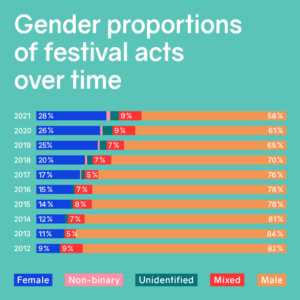How’s the gender balance in 2022?
Electric Indigo’s female:pressure collective have analysed festival line-ups from the past 10 years to see how much progress is being made to make things fair.
The debate around gender parity in dance music is never far from the discourse online, or so it seems if you engage with any corner of ‘techno Twitter’ and other such realms. Speaking from a personal, and admittedly male, perspective, it has seemed like there has been a widespread cultural shift towards achieving a healthier balance of women, non-binary / trans / LGBTQI+ folk and men on event line-ups. The idea of programming a line-up of wall-to-wall dudes feels like a basic, embarrassing failure in 2022. But while there are plenty of events quite clearly embracing this spirit, not a week goes by without someone rightly pointing out another tiresome sausage fest catering to an industry model which feels distinctly old-world.
Perspective is all well and good, but sometimes factual analysis is what’s needed to cut through the noise and take a view on how things actually are. Enter female:pressure, the long-standing feminist electronic music collective established by Susanne Kirchmayr, aka Electric Indigo, in 1998. Marking International Women’s Day in 2022, they’ve published a survey called FACTS 2022, which they describe as, “a continuous project undertaken by volunteer members of the female:pressure network to quantify the gender distribution of artists performing at electronic music festivals worldwide.” So, what have they found out?

“The proportion of female acts rose from 9.2% in 2012 to 26.9% in the current reporting period of 2020 to 2021. As of 2021, 1.3% of all acts surveyed are non-binary and 9.1% are mixed in comparison to 59.1% male acts.”
So progress is definitely being made, but you can see why the FACTS survey was urgently needed in 2012, with less than a tenth of artists on line-ups being female. female:pressure have been proactive in engaging the industry directly on this topic, especially as the debate around the issue has risen in prominence in the media over the past 10 years. Interestingly, out of the 159 festivals evaluated for the survey, only 28 willingly submitted their own data to the survey. One of the pervasive truths is that the bigger, more commercial festivals are the furthest from reaching any kind of gender parity.
“The progress is steady but slow, but the interesting things are in the details and in the context,” Kirchmayr told us in the wake of the publishing of the report. “For example if you compare European to North American festivals, the European ones are doing a lot better in terms of gender diversity, and I assume the reason for that is public funding, and public funding in Europe usually comes with certain restrictions or demands in terms of gender diversity.”

“Structural sexism perpetuates inequality by creating barriers and disincentives for artists of marginalized genders, limiting success in the arts to the status quo,” they explain in the survey. “While this phenomenon is receiving more media coverage today, we believe that measuring trends through the FACTS survey is necessary to understand developments in the electronic music industry and to hold decision-makers accountable.”
It’s also worth noting their categorisation of other genders besides female and male. It’s a thorny issue of course, and one which female:pressure debated intensely before conceding to non-binary to address all other genders. Their rationale is thus; “despite being an organization that recognizes many more genders beyond these categories… the industry as a whole generally does not. To address the industry’s inequality, therefore, necessitates the use of the language of the industry.”
The survey is presented in a methodical, engaging and easy to digest way – the kind of professional and transparent approach needed to help inspire positive change. It’s heartening to see things heading in the right direction, and the theory would be that exponentially this will continue to grow. There are more female / non-binary-focused initiatives to introduce folks to DJing and production, and as more non-male artists appear in front of a crowd, so too more people can be inspired to follow their own creative ambitions.
More than just a declaration of the state of things, FACTS 2022 also lays out constructive ways to move forwards in addressing these issues, with advice for festival organisers, journalists, attendees and more besides. From inclusion riders for artists to delegating booking duties to encourage diversity, committing balanced coverage and calling out regressive line-ups, there’s a lot of positive action we can all take to keep that trend heading in the right direction. Quite simply, any event or experience is better when there’s a balanced approach to gender, and festivals have a unique power to act as microcosms of the wider world. Bold ideas about how to improve society can start in these places, from environmental improvements to social etiquette, so improvements here can only help address the issues in wider society.